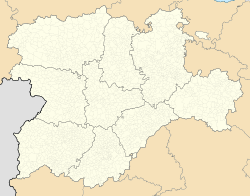Tejado facts for kids
Quick facts for kids
Tejado
|
|
|---|---|

A view of Tejado
|
|
| Country | |
| Autonomous community | |
| Province | |
| Municipality | Tejado |
| Area | |
| • Total | 77 km2 (30 sq mi) |
| Population
(2018)
|
|
| • Total | 106 |
| • Density | 1.377/km2 (3.57/sq mi) |
| Time zone | UTC+1 (CET) |
| • Summer (DST) | UTC+2 (CEST) |
Tejado is a small town, also called a municipality, located in Spain. It's found in the Soria province, which is part of the Castile and León region. In 2018, about 106 people lived there.
Contents
Discovering Tejado
Tejado is a quiet and interesting place in Spain. It's known for its peaceful environment and its location in a beautiful part of the country. Learning about places like Tejado helps us understand more about different cultures and ways of life.
Where is Tejado Located?
Tejado is in the north-central part of Spain. It belongs to the province of Soria. This province is famous for its natural beauty and historical sites. The town is also part of the larger Castile and León region. This region is one of the biggest in Spain.
How Big is Tejado?
The municipality of Tejado covers an area of about 77 square kilometers. To give you an idea, that's roughly the size of a small city. However, it has a very small population. In 2018, only about 106 people lived there. This makes Tejado a very quiet and spread-out community.
What is a Municipality?
In Spain, a municipality is like a local government area. It's similar to a town or a small district. Each municipality has its own local council that manages things like roads, public services, and local rules. Tejado is one of many municipalities in the Soria province.
Life in Tejado
Life in Tejado is likely very calm due to its small population. People living there probably know each other well. The area's natural surroundings offer a peaceful place to live.
Time Zone Information
Tejado follows Central European Time (CET). This means it is one hour ahead of Coordinated Universal Time (UTC+1). During the summer months, they switch to Central European Summer Time (CEST). This makes them two hours ahead of UTC (UTC+2). This change helps make the most of daylight hours.
Images for kids
See also
 In Spanish: Tejado (Soria) para niños
In Spanish: Tejado (Soria) para niños



